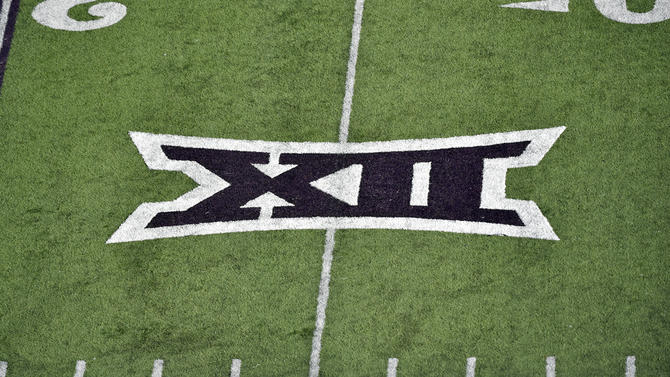IRVING, Texas -- The question now is how bad-ass the Big 12 wants to be.
Suddenly, Conference Conflict has swagger and leverage. Please, no more jokes about being on life support and other leagues picking over the Big 12 for used parts like an old wreck.
More importantly, the conference has a future. It all centers around a decision that is one of the more significant in college sports in recent years.
That was evident Friday after the conclusion of the Big 12 Spring Meetings.
Sure, the league added a championship game at the same time it announced record revenue distribution ($30.4 million per team). But it also suddenly holds the near-term outlook of Fox, ESPN and the Big Ten in its hands.
Big 12 presidents know this. It was explained to them this week as consultants laid out various options. It's up to them to swing their swords as hard as they can.
To summarize ...
The $1 billion non-decision: We know its television partners have to pay the Big 12 as much as $1 billion if it expands by as many as four teams. That's $1 billion ESPN and Fox theoretically won't have at the same time the Big Ten goes to market to finalize the second half of its deal. Fox is reportedly paying $1.5 billion to the Big Ten for the first half of those rights.
But ESPN/Fox has to pay the Big 12 in expansion if it comes to that. They want the rights to the Big Ten. See how the Big 12 could upset a lot of folks by cashing in?
"I'm aware of that," Big 12 commissioner Bob Bowlsby said, dryly. "It's probably not fair to say it's a zero-sum game, but it's not unrelated."
Oklahoma president David Boren said the discussion over adding teams was "ongoing." He continued: "There was no feeling we're going to slow our look at expansion."
To that point, Big Ten commissioner Jim Delany has mentioned he would like to have his deal done some time around the Big Ten Media Days in late July. Bowlsby said he hopes to have a decision on expansion by the end of summer.
ESPN wouldn't pass on the Big Ten because it had to pay the Big 12, would it?
One Big 12 official gave a "So what?" shrug to the prospect of upsetting its rightsholders. Wow. Before that moment, who would have thought the Big 12 could throw its weight around in a phone booth?
So as the Big 12 celebrated re-institution of its league title game Friday -- while the taste for expansion seemed somewhat diminished -- it also knew its influence and impact could grow.
"As a theory, that's true," Bowlsby added.
For now, The League We Love To Mock is going retro. The championship game will start in 2017, likely between two division winners. (Divisions, or even the idea to have them, have not been finalized.)
"The rumors of our demise," Texas Tech interim president John Opperman said, "are greatly exaggerated."
The biggest Big 12 upshot: All the Power Five schools now have that 13th data point. No more angst about the Big 12 playing regular-season games while the other big boys are deciding their champions on grand stages.
Don't forget, that philosophical difference is the reason we're here in the first place. The Big 12 freaked the moment Baylor and TCU got left out of the College Football Playoff in 2014.
After much hand-wringing, we're back where the league was from 1996-2010 -- playing a championship game.
"If, indeed, we're still playing a full round-robin and we have a championship game, I think our means of determining our champion is the strongest of all the conferences," Bowlsby said.
Cue the triumphant return of "One True Champion?"
Mo' money: Revenue has risen 20 percent to that $30.4 million figure. Bowlsby said that puts the league third overall behind the SEC and Big Ten. That's exactly where the Big 12 wants to be because it probably can't ever surpass those two powerhouses. And that's OK. The Big 12 matters again. Now it just needs to go out and chase the CFP each year. With that league championship game, it thinks it can.
No championship game = big problems: While not playing a championship game, the Big 12's highest ranked team dropped in the final week despite winning in the first two years of the CFP. That would be TCU dropping from third to sixth in 2014 and Oklahoma going from third to fourth in 2015.
Taking full advantage of deregulation? While nothing is decided, the Big 12 could be the first conference to take advantage of championship game deregulation by the NCAA.That means the Big 12 could match its two best teams each season, theoretically increasing the likelihood of the game's winner advancing to the CFP.
That would be instead of matching division winners, which could create a potentially crippling upset by an inferior team. It's happened to the Big 12 -- several times. Six times in the previous 15 Big 12 title games, the underdog either covered or won outright. The league lost three BCS title game contenders in those upsets.
Research by CBS Sports shows that if the Big 12 had matched its two best teams from 1996-2010, it wouldn't have mattered in the championship chase. The higher-ranked team still would have had to win to play in the BCS title game.
The prospect of a rematch in the champ game is enticing if it's done right. That might mean moving Oklahoma-Oklahoma State to earlier in the season. In a best-two-teams scenario, the rivals would have played in back-to-back weeks last season.
The Big 12 estimates it will get a $27-28 million bump per season from playing the championship game. That doesn't include concessions and ticket revenue. That means, by 2017, the per-team take could be up to $33 million.
Raising the profile, just not a network: The whole idea of this exercise was to not only raise the conference's revenue but raise its profile. The league was told by its consultants last month it had a 62 percent chance of getting in the CFP if it stayed status quo. By adding a championship game and expanding, that average grows to 75 percent.
So, no, expansion can't be dead.
The conference will not do a network, which is no surprise. It may just well be that the Big Ten and SEC networks are all that the market can support. Simply put, that's OK as far as the Big 12 is concerned.
Oklahoma on its own makes $7 million in third-tier rights that would have to be shifted to a network. Kansas has a unique deal with Time Warner in the Kansas City area.
"Linear networks are sort of yesterday's technology," Bowlsby said.
That technology includes the contentious Longhorn Network. But Texas has to be more than happy getting $30.4 million plus the $15 million a year it receives annually from ESPN for LHN.
For now, everyone in the Pure Prairie League is happy. They're playing an extra game. They're making more money. And they may not be done yet.
Big 14, anyone? That sounds so bad-ass.
"Kind of got busy with it, didn't we?" a gleaming Bowlsby said.






















